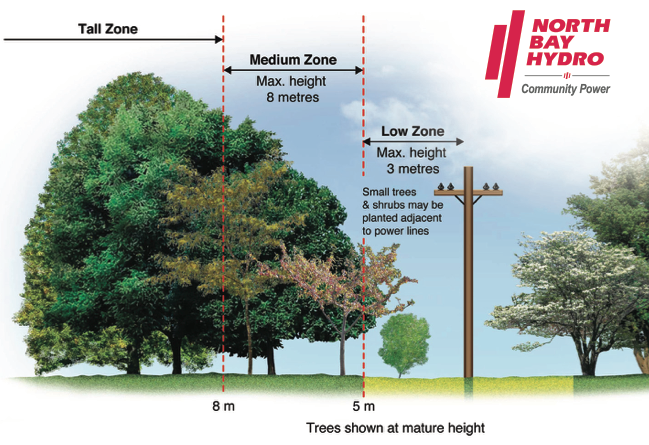Vegetation Management
Why do we perform vegetation management?
Tree contact with power lines accounts for 30 per cent of outages in Ontario and can lead to serious fires and property damage. North Bay Hydro’s Vegetation Management Program has been designed to maintain our utility corridors on a 4-year cycle to prevent the risk of potential between trees and limbs and the high voltage electrical wires that serve our community. Our vegetation management program is performed by highly skilled and qualified individuals to ensure both public safety and, the uninterrupted delivery of reliable electrical service.
Most Hydro service interruptions in Ontario are caused by tree contact with power lines.
Keeping lines safe and clear
It is our responsibility to maintain safe minimum clearance between trees and utility lines as well as a consistent supply of service to homes and businesses throughout our jurisdiction. We take tree clearance requirements for power lines very seriously and ensure that all of our lines are kept clear to ensure that our customers receive the power they need, when they need it. With power lines carrying up to 44,000 volts, it is crucial to the safety of our community that trees are kept from contacting these high voltage circuits.
How can you help?
If you are planning to plant new trees or shrubs on your property, always make note of overhead and underground power lines. It is also important that you check the maximum growing height of the species you want to plant and select an appropriate planting location. By accounting for minimum clearances, and planting the right trees in the right places, you can benefit from the beauty and value of vegetation while helping us continue to deliver reliable electricity service.
What are minimum clearances?
Minimum clearance refers to the ground distance between our power lines and any vegetation. Because different species grow to different heights, there are a number of important factors that determine proper clearances. Minimum clearance distances must account for the point of maximum sag, the lowest possible distance our distribution lines can descend towards the ground. Lines will sag more on warm summer days than on cold winter days, and will also sag more as the electricity load increases. A highly loaded transmission line can sag several metres more during the summer than the same line carrying the same amount of electricity over the winter months. You should also account for plant growth over a general target of six to eight-year cycles to ensure minimum clearances will be maintained over time. Minimum clearance rules also apply to underground utility assets where a distance of 1.5 metres is recommended.
Minimum clearance is regulated by the Occupational Health and Safety Act (OHSA), and the Electrical Utility Safety Authority (EUSA).
The benefits of proper tree planting
Trees and other plant types beautify our neighborhoods, provide shade on warm days, and improve our air quality, and can help conserve energy. Properly placed trees can reduce your home’s energy costs by 10 to 50 per cent. Evergreen wind breaks on the west or north side of your house can help reduce heating costs in the winter and the shade provided by deciduous trees to the south or west of your home will reduce your need for air conditioning in the summer, while still allowing natural heat from the sun in the winter. Proper tree selection and placement will enhance your property’s value and prevent costly future damage to your home while providing an appealing landscape that supports efficient distribution and consumption of energy. North Bay Hydro professionals can help guide property owners to plant the right tree in the right place.
Right Tree, Right Zone
Tall Zone
At least 8 m away from overhead power lines. Tall-growing trees include Colorado spruce, white pine and sugar maple.
Medium Zone (8m max. height)
From 5 – 8 m on either side of the lines. Medium zone trees include serviceberry, ornamental pear and white cedar.
Low Zone (3m max. height)
Extends 5 m on either side of the lines. Low-growing trees and shrubs include dogwood, honeysuckle and silverberry. Please keep a 5 m radius around distribution poles clear of vegetation. for maintenance work and emergency restoration efforts.
Additional questions or concerns?
Together, we can work toward the efficient delivery of electricity while still enjoying the beauty and value that healthy, responsibly planted trees provide. If you have any questions about proper planting locations or would like to locate underground power lines on your property, please call Ontario One Call at 1-800-400-2255 or submit an e-ticket at www.on1call.com. For additional information about tree planting guidelines and maintenance, please refer to the Electrical Safety Authority’s Landscaping and Tree Trimming Resources.





 Accessibility
Accessibility